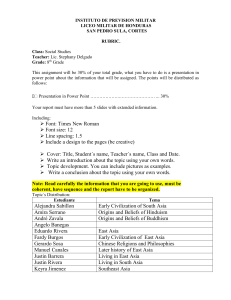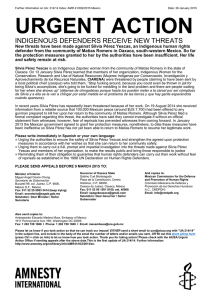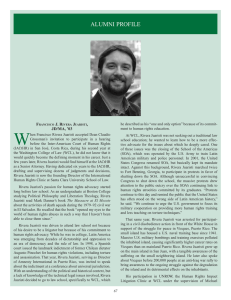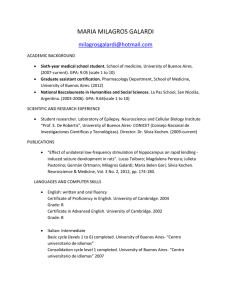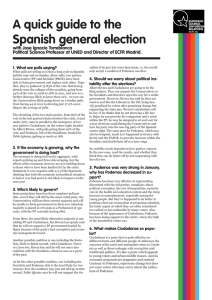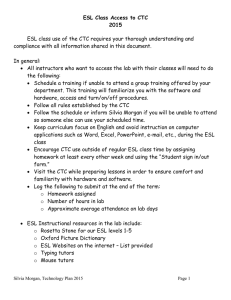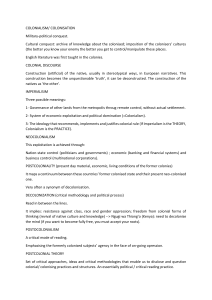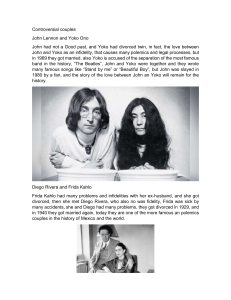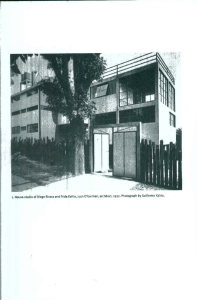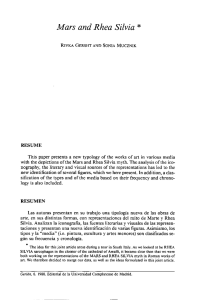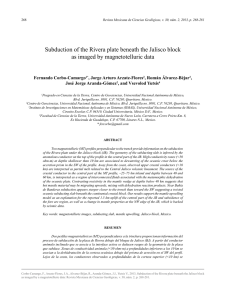Sociology of the Image Orality, Performance, and the Gaze
Anuncio
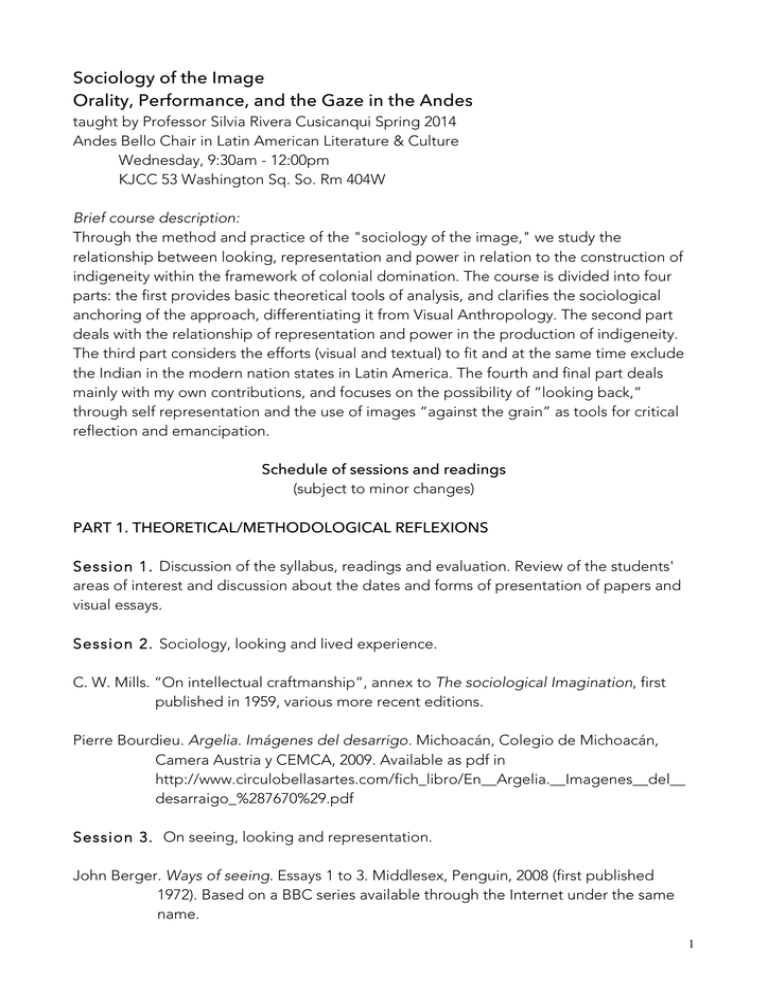
Sociology of the Image Orality, Performance, and the Gaze in the Andes taught by Professor Silvia Rivera Cusicanqui Spring 2014 Andes Bello Chair in Latin American Literature & Culture Wednesday, 9:30am - 12:00pm KJCC 53 Washington Sq. So. Rm 404W Brief course description: Through the method and practice of the "sociology of the image," we study the relationship between looking, representation and power in relation to the construction of indigeneity within the framework of colonial domination. The course is divided into four parts: the first provides basic theoretical tools of analysis, and clarifies the sociological anchoring of the approach, differentiating it from Visual Anthropology. The second part deals with the relationship of representation and power in the production of indigeneity. The third part considers the efforts (visual and textual) to fit and at the same time exclude the Indian in the modern nation states in Latin America. The fourth and final part deals mainly with my own contributions, and focuses on the possibility of “looking back,” through self representation and the use of images “against the grain” as tools for critical reflection and emancipation. Schedule of sessions and readings (subject to minor changes) PART 1. THEORETICAL/METHODOLOGICAL REFLEXIONS Session 1. Discussion of the syllabus, readings and evaluation. Review of the students' areas of interest and discussion about the dates and forms of presentation of papers and visual essays. Session 2. Sociology, looking and lived experience. C. W. Mills. “On intellectual craftmanship”, annex to The sociological Imagination, first published in 1959, various more recent editions. Pierre Bourdieu. Argelia. Imágenes del desarrigo. Michoacán, Colegio de Michoacán, Camera Austria y CEMCA, 2009. Available as pdf in http://www.circulobellasartes.com/fich_libro/En__Argelia.__Imagenes__del__ desarraigo_%287670%29.pdf Session 3. On seeing, looking and representation. John Berger. Ways of seeing. Essays 1 to 3. Middlesex, Penguin, 2008 (first published 1972). Based on a BBC series available through the Internet under the same name. 1 Walter Benjamin. “The work of art in the age of mechanical reproduction,” in Illuminations, first published in English in 1968. John Berger and Jean Mohr. Another way of telling. New York, Vintage, 2005 (first edition, Pantheon 1982) Session 4. Representation as culturally embedded practice. Stuart Hall. Representation. Cultural representations and signifying practices, Sage-The Open University, London 1997. Chapter 1, “The work of representation.” The students may each read one additional chapter of this book by affinity for group discussion. Part 2. THE GAZE, POWER AND THE CONSTRUCTION OF ETHNICITY. Session 5. Connotations and meaning: on how to “load” representations. Roland Barthes. “The photographic message,” “Rhetoric of the image,” and “The third meaning,” in Image, Music, Text. Tr. Stephen Heath. First French edition, 1973, New York, Hill and Wang 1978. Roland Barthes. Camera Lucida. Tr. Richard Howard, New York, Hill and Wang, 1981. Session 6. On the power of looking at the Other. Michael Foucault. Discipline and Punish. The birth of the prison. Tr. Alan Sheridan. New York: Vintage, 1977 (3 Chapters from the section on Discipline). Wolfram Hartmann, Jeremey Silvester and Patricia Hayes (eds) The colonizing camera. Photographs in the making of Namibian history. Cape Town: University of Cape Town Press. 1998 Session 7. The figuration of race and land in visual narratives of conquest. Deborah Poole. Vision, race and modernity. A visual economy of the Andean image world. Princeton, Princeton University Press, 1997. Ch. 3, “An economy of vision”, and Ch. 5, “Equivalent images”. Mary Louise Pratt. Imperial Eyes. Travel writing and transculturation. London and New York: Routledge. 1992. Part II. The reinvention of America. Margarita Alvarado and Carla Moller. Memoria visual e imaginarios. Fotografías de pueblos originarios. Siglos XIX-XXI. Santiago de Chile, Museo de la Memoria 2 y los Derechos Humanos. PART 3. NATION-BUILDING AND THE “INDIAN PROBLEM” Session 8. Liberal states and heterogeneity: (un)fitting Indians into the Nation. Blanca Muratorio. “Discursos y Silencios sobre el Indio en la Conciencia Nacional”, and “Nación, Identidad y Etnicidad: Imágenes de los Indios Ecuatorianos y sus Imagineros a Fines del Siglo XIX”, in Imágenes e Imagineros. Representaciones de los indígenas ecuatorianos, siglos XIX y XX. Quito, FLACSO, 1994. Gabriela Zamorano. “Traitorous Physiognomy: Photography and the racialization of Bolivian Indians by the Créqui-Montfort expedition (1903)”, in The Journal of Latin American and Caribbean Anthropology, Vol 16, No. 2, 2011. Session 9. Representing the Nation/State, Market and Identities. Silvia Rivera Cusicanqui "Secuencias iconográficas en Melchor María Mercado", in Rossana Barragán, Seemin Quayum and Magdalena Cajías (comps) El Siglo XIX. Bolivia y América Latina, La Paz, IFEA-Historias, 1997. Seeming Qayum Ch. 2: “The traveller's eye: Science, Space and Race” and Ch.3: “The view from within: patriotism, patriarchy and the bounds of national identity”, in Creole Imaginings. Race, Space and Gender in Republican Bolivia. (unpublished PhD Thesis) Session 10. Imagi-Nation and the populist State in Bolivia Silvia Rivera Cusicanqui “El mito de la pertenencia de Bolivia al mundo occidental. Réquiem para un nacionalismo”, in Temas Sociales, No. 24, 2003. Silvia Rivera Cusicanqui. “Representación de indios y mujeres en el Estado de 1952: el “miserabilismo” del Álbum de la Revolución”, in Martin Lienhard (editor) Discursos sobre (l)a pobreza. América Latina y/e países luso africanos. MadridFrankfurt, Iberoamericana Vervuert, 2006. PART 4. LOOKING BACK Session 11. Baroque imagination and lived religious practices. Silvia Rivera Cusicanqui and El Colectivo 2: Principio Potosí Reverso. Madrid, Museo Reina Sofía, 2010. 3 Session 12. An “emic” and visual theory of colonial society. Silvia Rivera Cusicanqui. “La universalidad de lo ch’ixi. Miradas de Guamán Poma”, in Ch’ixinakax utxiwa. Sobre prácticas y pensamientos descolonizadores. Buenos Aires, Tinta Limón, 2010. Accesible through the blog chixinakax.wordpress.com Rolena Adorno. Writing and resistance in colonial Peru. Austin, The University of Texas Press, 1986 (Chapters to be distributed according to affinity). Session 13. Image, metaphor and (post)colonial critique. Silvia Rivera Cusicanqui. “Alternative Histories. An essay on two sociologists of the Image”, in (In)Visible realities: Internal Markets and Subaltern Identities in Contemporary Bolivia. Southeast Asian Studies Regional Exchange Program. Quezón City. Philippines, 2005. Silvia Rivera Cusicanqui. “Pensando desde el Nayrapacha: una reflexión sobre los lenguajes simbólicos como práctica teórica”, in Pensares y Quehaceres, No. 9, México 2010. Session 14. Modernity, resistance and memory. Silvia Rivera Cusicanqui. A visual and performative essay: “On un-walking the Illampu Street. An essay on the paradoxes of (post)colonial modernity” (slide show, unpublished). Maurice Hallbwachs. “Space and the collective memory”, Chapter 4 of The Collective Memory, first published in French in 1950. Trans. Lewis Coser, Chicago, The University of Chicago Press, 1992. In http://web.mit.edu/allanmc/www/hawlbachsspace.pdf Session 15. Screening of critical film production on the subject. Selection of sequences from CEFREC' indigenous film project and Ivy Maarey by Juan Carlos Valdivia. Sesión 16. Public presentation of individual visual essays and research results. 4

